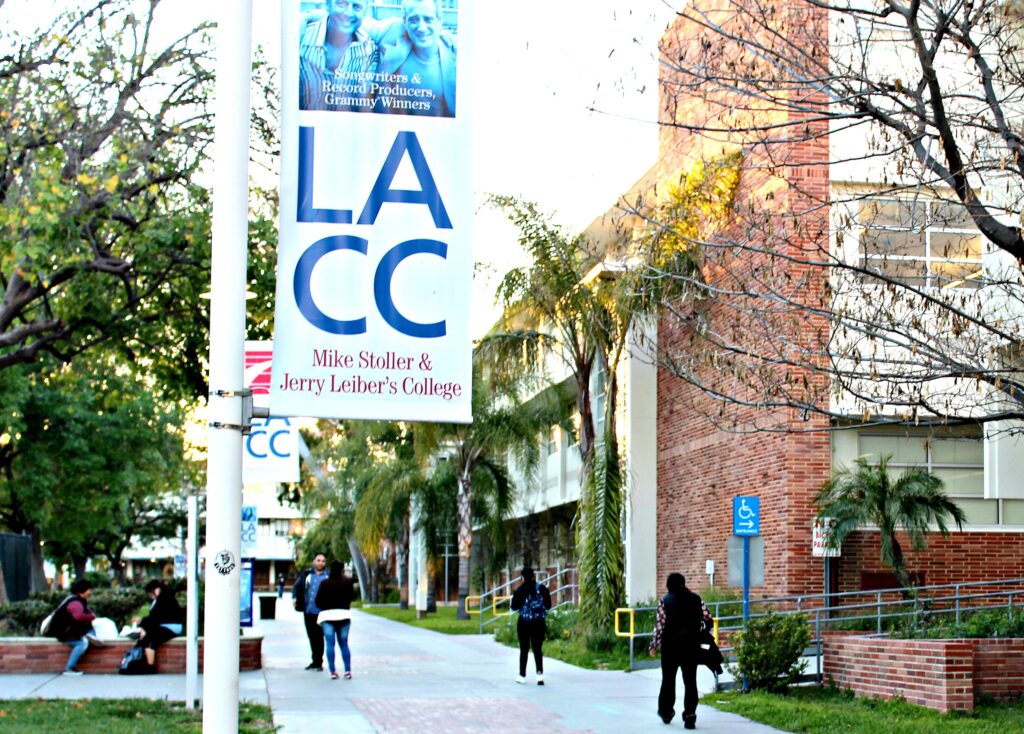
Los Angeles City College, one of the state’s 116 community colleges.
Larry Gordon/EdSource Today
Thousands of current and prospective California Community College (CCC) students are being crushed by unmanageable college and living expenses and hefty student loans.
That’s the finding of a new report from The Institute for College Access & Success (TICAS) and Student Senate for California Community Colleges (SSCCC). Our researchers analyzed data from state and federal officials to shine a light on the complex financial challenges plaguing community college students, particularly students of color.
The conclusion is clear: We must make community college more affordable and accessible.
Before diving into the findings, it’s important to understand the unique challenges of community college students. Many come from low-income backgrounds and experience food and housing insecurity while pursuing their postsecondary dreams. Many also financially support a child or other family members.
Unfortunately, the report found that community college can quickly become too expensive for these students to manage, and could even be more costly than public universities. Our researchers analyzed the price of various community colleges — including tuition, food, housing, textbooks and materials, and transportation — for a student whose family made less than $30,000 annually. We found that, including potential grant aid, Butte College still had an annual net price of $14,600. Cuesta College cost $18,900, and Long Beach City College came in at $20,200.
Furthermore, community college students often struggle to access grant aid. Prospective students may be unaware of their aid eligibility or lack the support to navigate the full application process. In 2019-20, only 51% of community college students in California applied for federal financial aid, compared with 75% of students attending public four-year universities.
All in all, 54% of students attending the state’s community colleges did not receive a single drop of grant aid in 2019-20.
Public university students, meanwhile, often fare better with financial aid because they are eligible for more generous and robust financial support from the state and their institutions. For example, unlike California community college students, they are eligible for funds from the Middle Class Scholarship for individuals pursuing a teaching credential.
As a result, thousands of community college students, particularly students of color, take out student loans. Alarmingly, while Black students made up just 5% of the California community college enrollment in 2021-22, they accounted for 20% of student borrowers.
Community college students also try to make ends meet by working while taking classes. More than 3 in 4 community college students surveyed in the 2021-22 Student Expenses and Resources Survey (SEARS) reported working at least 21 hours a week, compared with just half of their peers at California State University, University of California, and private, nonprofit institutions. And almost half of community college respondents worked at least 36 hours — nearly a full-time job.
Unfortunately, research shows that excessive work hours can negatively impact students’ academic success by slashing the time they have to learn and study.
California must do better.
It is critical to expand access to aid opportunities for community college students. First and foremost, policymakers can follow through on their commitment to reform the Cal Grant program. After years of advocacy, legislators agreed in the 2022-23 California state budget to expand eligibility to more low-income students, ensure student awards kept pace with inflation, and more. But they still haven’t provided the funding needed to complete these reforms — and the 2024-25 state budget doesn’t include it. We simply can’t keep putting this on the back burner.
In the meantime, state leaders should pursue other routes to increase aid opportunities. California just submitted a proposal to the U.S. Department of Education to enable students without a high school diploma — or the equivalent — to access federal assistance for higher education, known as Title IV financial aid. This could be a big step forward in supporting community college students if allowed.
Policymakers and community colleges should also explore innovative ways to ensure that incoming students complete the Free Application For Federal Student Aid (FAFSA) or California Dream Act Application (CADAA). While high school students are required to submit a FAFSA or CADAA, many prospective community college students take years off between high school and postsecondary education. Increasing completion rates can maximize access to aid for those students.
Additionally, we urge policymakers to make the Student Success Completion Grant — which helps community college students cover their education and living expenses — more equitable. The grant is currently only available to those who attend full-time — generally, students with fewer external work and family responsibilities. And the amount of aid varies significantly. Students taking 12 -14.999 credits can only receive $1,298 per semester. However, once they hit 15 credits, that amount jumps to $4,000 per semester.
California Community Colleges are designed to serve all communities and uplift students from every walk of life. With intentional reforms that support the whole student, we ensure that all Californians have equitable and affordable access to a quality education at their local community college.
Manny Rodriguez is California director of policy and advocacy at The Institute for College Access and Success (TICAS).
Ivan Hernandez is a student at Diablo Valley College and the president of the Student Senate for California Community Colleges (SSCCC).
The opinions in this commentary are those of the authors. If you would like to submit a commentary, please review our guidelines and contact us.

